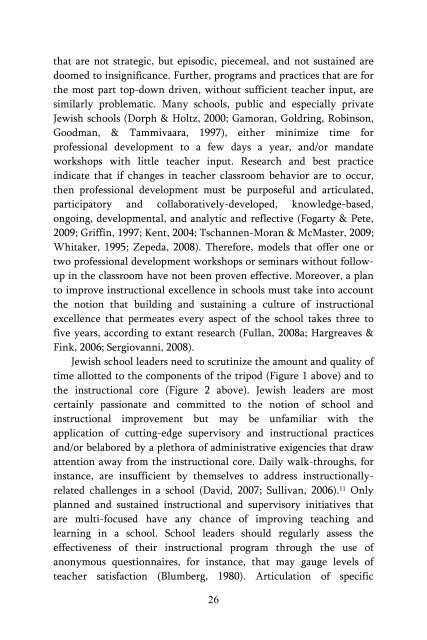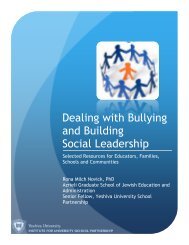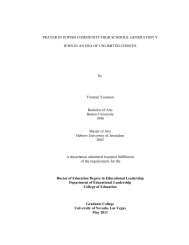Improving Instructional Quality in Jewish Day Schools and Yeshivot ...
Improving Instructional Quality in Jewish Day Schools and Yeshivot ...
Improving Instructional Quality in Jewish Day Schools and Yeshivot ...
Create successful ePaper yourself
Turn your PDF publications into a flip-book with our unique Google optimized e-Paper software.
that are not strategic, but episodic, piecemeal, <strong>and</strong> not susta<strong>in</strong>ed aredoomed to <strong>in</strong>significance. Further, programs <strong>and</strong> practices that are forthe most part top-down driven, without sufficient teacher <strong>in</strong>put, aresimilarly problematic. Many schools, public <strong>and</strong> especially private<strong>Jewish</strong> schools (Dorph & Holtz, 2000; Gamoran, Goldr<strong>in</strong>g, Rob<strong>in</strong>son,Goodman, & Tammivaara, 1997), either m<strong>in</strong>imize time forprofessional development to a few days a year, <strong>and</strong>/or m<strong>and</strong>ateworkshops with little teacher <strong>in</strong>put. Research <strong>and</strong> best practice<strong>in</strong>dicate that if changes <strong>in</strong> teacher classroom behavior are to occur,then professional development must be purposeful <strong>and</strong> articulated,participatory <strong>and</strong> collaboratively-developed, knowledge-based,ongo<strong>in</strong>g, developmental, <strong>and</strong> analytic <strong>and</strong> reflective (Fogarty & Pete,2009; Griff<strong>in</strong>, 1997; Kent, 2004; Tschannen-Moran & McMaster, 2009;Whitaker, 1995; Zepeda, 2008). Therefore, models that offer one ortwo professional development workshops or sem<strong>in</strong>ars without followup<strong>in</strong> the classroom have not been proven effective. Moreover, a planto improve <strong>in</strong>structional excellence <strong>in</strong> schools must take <strong>in</strong>to accountthe notion that build<strong>in</strong>g <strong>and</strong> susta<strong>in</strong><strong>in</strong>g a culture of <strong>in</strong>structionalexcellence that permeates every aspect of the school takes three tofive years, accord<strong>in</strong>g to extant research (Fullan, 2008a; Hargreaves &F<strong>in</strong>k, 2006; Sergiovanni, 2008).<strong>Jewish</strong> school leaders need to scrut<strong>in</strong>ize the amount <strong>and</strong> quality oftime allotted to the components of the tripod (Figure 1 above) <strong>and</strong> tothe <strong>in</strong>structional core (Figure 2 above). <strong>Jewish</strong> leaders are mostcerta<strong>in</strong>ly passionate <strong>and</strong> committed to the notion of school <strong>and</strong><strong>in</strong>structional improvement but may be unfamiliar with theapplication of cutt<strong>in</strong>g-edge supervisory <strong>and</strong> <strong>in</strong>structional practices<strong>and</strong>/or belabored by a plethora of adm<strong>in</strong>istrative exigencies that drawattention away from the <strong>in</strong>structional core. Daily walk-throughs, for<strong>in</strong>stance, are <strong>in</strong>sufficient by themselves to address <strong>in</strong>structionallyrelatedchallenges <strong>in</strong> a school (David, 2007; Sullivan, 2006). 11 Onlyplanned <strong>and</strong> susta<strong>in</strong>ed <strong>in</strong>structional <strong>and</strong> supervisory <strong>in</strong>itiatives thatare multi-focused have any chance of improv<strong>in</strong>g teach<strong>in</strong>g <strong>and</strong>learn<strong>in</strong>g <strong>in</strong> a school. School leaders should regularly assess theeffectiveness of their <strong>in</strong>structional program through the use ofanonymous questionnaires, for <strong>in</strong>stance, that may gauge levels ofteacher satisfaction (Blumberg, 1980). Articulation of specific26










